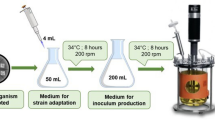The thermotolerant fungus, Aspergillus niger NCIM 563, was used for production of extracellular phytase on agricultural residues: wheat bran, mustard cake, cowpea meal, groundnut cake, coconut cake, cotton cake and black bean flour in solid state fermentation (SSF). Maximum enzyme activity (108 U g−1 dry mouldy bran, DMB) was obtained with cowpea meal. During the fermentation phytic acid was hydrolysed completely with a corresponding increase in biomass and phytase activity within 7 days. Phosphate in the form of KH2PO4 (10 mg per 100 g of agriculture residue) increased phytase activity. Among various surfactants added to SSF, Trition X-100 (0.5%) exhibited a 30% increase in phytase activity. The optimum pH and temperature of the crude enzyme were 5.0 and 50°C respectively. Phytase activity (86%) was retained in buffer of pH 3.5 for 24 h. The enzyme retained 75% of its activity on incubation at 55°C for 1 h. In the presence of 1 mM K+ and Zn2+, 95% and 55% of the activity were retained. Scanning electron microscopy showed a high density growth of fungal mycelia on wheat bran particles during SSF. Journal of Industrial Microbiology & Biotechnology (2000) 24, 237–243.
Similar content being viewed by others
Author information
Authors and Affiliations
Additional information
Received 07 June 1999/ Accepted in revised form 18 December 1999
Rights and permissions
About this article
Cite this article
Mandviwala, T., Khire, J. Production of high activity thermostable phytase from thermotolerant Aspergillus niger in solid state fermentation. J Ind Microbiol Biotech 24, 237–243 (2000). https://doi.org/10.1038/sj.jim.2900811
Issue Date:
DOI: https://doi.org/10.1038/sj.jim.2900811




